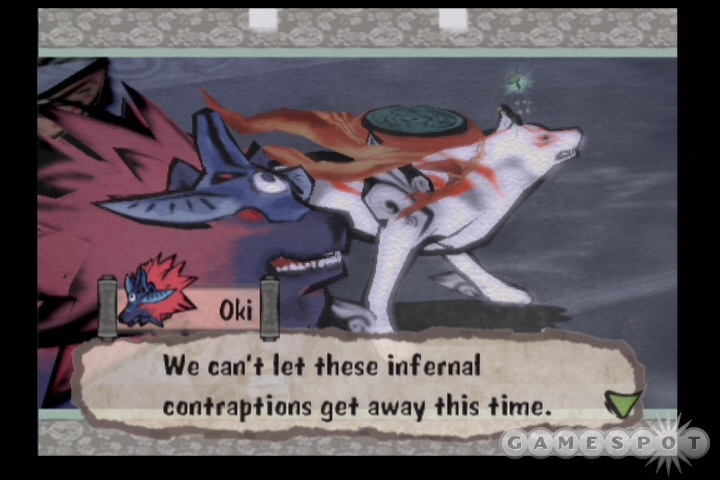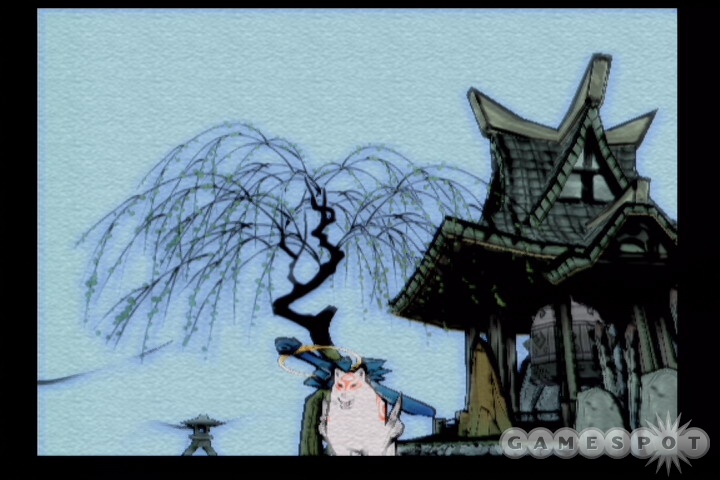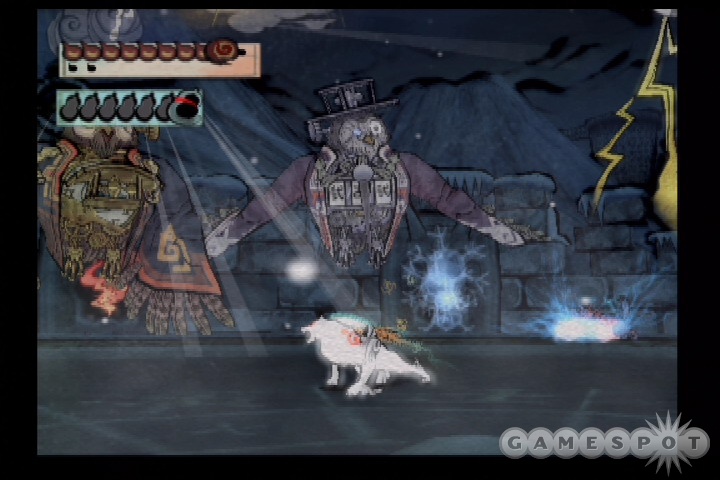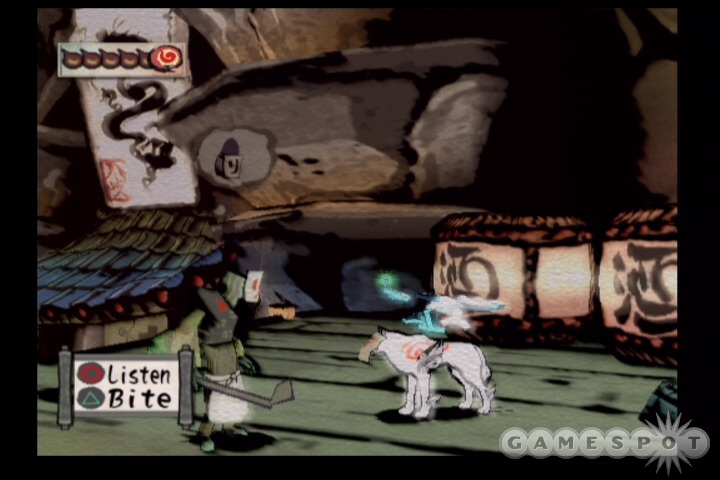It's only fitting that a game about a god should have an awe-inspiring presentation such as this. Okami is based on the Japanese legend of the sun god, Amaterasu, whom you control throughout the game in the form of a white wolf. A truly epic journey awaits this wolf, who wields divine power quite literally as an artist wields a brush. Despite its unusual premise and other unique qualities, Okami is in many ways a textbook action adventure game. It takes its cues from the Legend of Zelda series in particular and achieves similarly outstanding results. Much like in those games, in Okami you'll traverse a vast countryside filled with intrigue, meet a variety of interesting characters, delve into dungeons chock-full of various traps and fearsome-looking creatures, and become more and more powerful as you go. All the while, Okami's stunning good looks give it the appearance of a cross between a cartoon and a traditional Japanese ink-and-watercolor painting, and perhaps best of all, the game keeps going and going for much longer than most other games like it.

Though Okami's premise and characters are steeped in Japanese folklore, you don't need to be familiar with the source material to appreciate this game--you just need a bit of an open mind. The story plays out like a modernized anime version of a myth, except with a far more original visual style than what most anime brings to bear. The story is simple: Amaterasu, reborn as a white wolf, has a mission to rid medieval Japan of a demonic curse that's swept across the nation. Apparently, it's all the doing of a massive eight-headed serpent that was killed 100 years ago and has been reborn. Will history repeat itself, or is there an even more sinister plot at work here? At the beginning of the game, Amaterasu is joined by a pint-sized creature named Issun, a bold and smart-alecky little guy who does all the talking for the both of them. Their journey begins by purging the evil from a small village but expands to encompass all corners of Japan, and beyond. The story unfolds mostly through frequent, nicely animated cutscenes. There's a lot of dialogue throughout the game, which makes for plenty of reading since all the characters speak in gibberish that sounds just vaguely Japanese.
The story boils down to a conventional battle of good against evil but effectively sets up a series of remarkable, self-contained subplots that are all seamlessly interconnected. During your quest to purify Japan, you won't just battle that eight-headed serpent--you'll unearth the cause of a deadly plague threatening a huge city, help villagers in danger of freezing to death from a relentless blizzard, come face-to-face with an enormous water dragon that's terrorizing Japan's coastline, and more. While the game is a little dense with exposition, overall you'll feel like you've gone on an incredible and long journey once all is said and done. It helps that Okami will take you at least 30 hours to finish the first time through, and that's not due to any sources of frustration during the gameplay, either. Okami is very long for an action adventure game, especially for one that has so much beautiful scenery in it. If anything, the game probably could have shed a couple of hours for a slightly quicker, tighter pace, since the experience can start to drag in a few spots, such as an obligatory fight-all-the-bosses-again sequence near the end. The game's scarce shortcomings are all this minor.

Just running around in the world can be exciting, which is fortunate, because there's a lot of running around to be done. Amaterasu, or "Ammy" as her companion likes to call her, can run very quickly and jump quite high, and when engaged in battle, she fights with a divine instrument on her back that acts like a sword. Since she's a wolf, she can also bark and dig holes, but that's not all. The most unusual aspect of Okami's gameplay is in the brush techniques you'll frequently have to use to defeat foes and reach places no man or wolf could go, and these represent her divine powers.
You'll learn more than a dozen different brush techniques over the course of the game, each gifted to Ammy by one of her fellow animal gods. These let her harness the power of the elements, slash clean through solid stone and other objects, rejuvenate plants, blow things up, and much more. To start using brush techniques, you just press and hold R1 to make the scene instantly switch to look like an ink painting on parchment while a large brush (that appears to be Ammy's tail) comes down from offscreen. Then you can draw these simple shapes and lines, corresponding to your different brush techniques, and miracles happen. For example, Ammy can change night into day if you paint a circle in the sky, or she can cleave an enemy in two if you paint a line straight across that foe. She can create large lily pads that serve as floating platforms in the water, and then summon gusts of wind that will push this makeshift boat along, among a variety of other uses. It's exciting to gain each new brush technique, as well as to discover new ways of putting together everything you've learned.
You'll need a bit of time to recharge your divine energies if you use too many brush techniques in rapid succession, but overall, you'll be using these moves regularly and often both while exploring and while in combat. The brushwork takes a little getting used to, but you'll have plenty of time to practice. The whole system winds up being novel and fairly deep, since some powers vary in effect depending on how you draw them. The game also has a number of puzzles and battles that make clever use of the different techniques you'll pick up as you go. In addition to learning brush strokes, Ammy will grow more powerful in other ways. For instance, she can learn new fighting moves from an eccentric martial arts master, one of the game's wildest-looking characters; you can increase her maximum health and celestial ink reserves; and she'll find multiple new weapons and many other items during the course of the game. You get a good, clear sense that your character is growing stronger and stronger as the story progresses.

Though Amaterasu has a daunting mission, the journey in Okami is never particularly difficult, mostly due to the abundance of health power-ups you'll find or that you can purchase. If there's a problem, it's that there's virtually no limit to how many of these items you can carry with you. You also have access to an "astral pouch" that can bring you back to life right on the spot should you run out of health, so with all that aid, it's possible and likely that you'll get all the way through Okami without ever seeing a "game over" screen. This is mostly to the game's credit, and it's still got some fairly challenging puzzles and jumping sequences, in addition to some other surprises in the form of a couple of fun minigames. The game's combat is also entertaining even though most of the fights, even against the biggest and seemingly deadliest foes, are quite easy. You'll encounter all kinds of imaginatively designed foes and get to lay into them with fierce-looking attacks, with some help from that divine brush of yours. The combat is fast-paced and, like everything else about Okami, it simply looks terrific.
Despite the sheer variety of demonic enemies in the game, combat isn't too frequent in Okami. As you explore the wilderness, you'll see packs of demons represented by floating talismans, and touching these will send you straight into the fight. However, it's easy to avoid most such encounters if you want to. While there's a lot of four-legged traveling to be done in Okami, since you run so quickly and the scenery looks so good, it's nothing if not pleasant. You do find means of fast transportation later on in the game, making it easy to cross from one side of Japan to the other in a flash. Much of the game also takes place in various towns and villages, in which you'll be speaking to dozens of unique characters, many of whom are quickly endearing due to the game's good dialogue and fantastic art style and animation. You'll also spend lots of quality time rejuvenating the land, bringing withered vegetation back to life, feeding woodland creatures, and so forth. This aspect of play is far more satisfying than it might sound like, partly because it's through these acts that Amaterasu earns praise, which functions as experience points that you can spend on improving your powers. Not that Amaterasu wouldn't be doing all these good deeds out of the goodness of her heart.
You'll be hard-pressed to find a better-looking game for the PlayStation 2. The game's look is unlike anything out there, with the possible exception of 2003's The Legend of Zelda: The Wind Waker for the GameCube, less because the art styles are similar and more because the art styles are each so distinctly stylized and skillfully presented. While Okami doesn't include support for widescreen progressive-scan displays, it still looks positively spectacular. The game's visual style is cohesive, original, and flawlessly executed. Every scene shimmers with life, except for the scenes that are covered in the thick, evil fog that disperses in a flourish of lush vegetation when Amaterasu works her magic. Great character designs both for human characters and for all the weird demonic foes you'll encounter further guarantee that you won't soon forget the unmistakable look of Okami. While the visuals alone aren't what make this such an impressive game, they enrich every moment you'll spend in the game's surreal world.

The audio is similarly excellent, though you might wish Okami's story was delivered in full speech. The sound effects are great, while a superb musical score filled with traditional Japanese instrumentation and modern melody accompanies most every sequence of play. It perfectly matches both the game's art style and its tone. Speaking of the tone, since Okami is basically a fairy tale, it's rather kid friendly...with the possible exception of the tiny Issun's occasional lascivious comments when he's in the presence of attractive young ladies. The game's good-natured attempts at humor lend it a likable, distinctly Japanese sense of weirdness.
Okami's long quest is filled with high adventure and gives you reason to come back for more once you've finally finished it. You can restart the journey with most of the weapons you've found and abilities you've acquired and try to seek out all the world's remaining secrets and side quests that you didn't find the first time. So there's much more to this game than you've probably come to expect from the typical action adventure experience, and the game is so well crafted from top to bottom that it's bound to impress just about anyone who gives it a chance. Now that the PlayStation 2 is in the sunset of its years as one of the most popular game systems ever released, it's somehow fitting that a game like Okami should come around to help ensure we'll carry a fond memory of the system long after we've moved on.